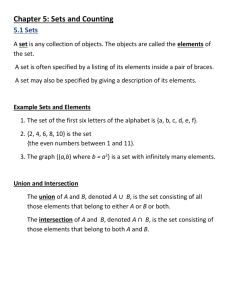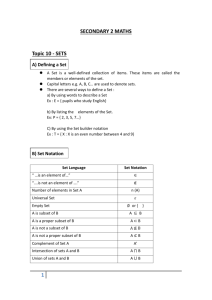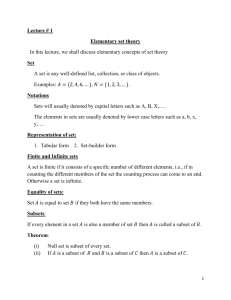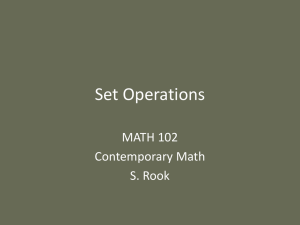Lecture 2 and 3.pages
advertisement
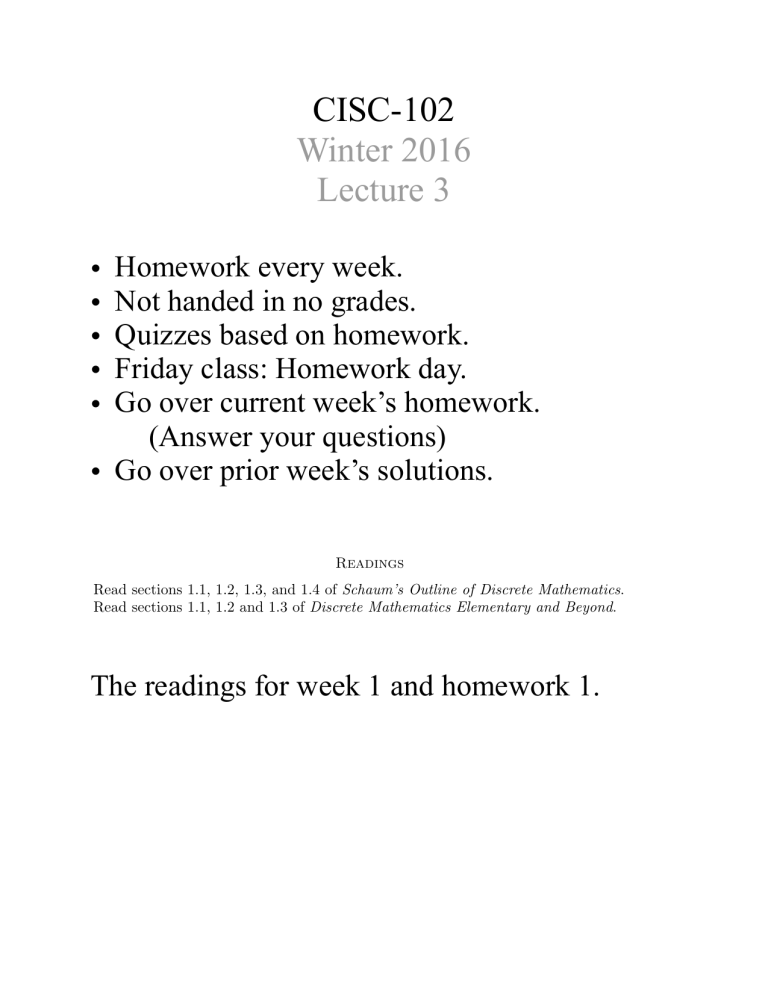
CISC-102
Winter 2016
Lecture 3
•
•
•
•
•
•
!
Homework every week.
Not handed in no grades.
Quizzes based on homework.
Friday class: Homework day.
Go over current week’s homework.
CISC-102 FALL 2015
(Answer your questions)
Go over prior week’s solutions.
HOMEWORK 1
Please work on these problems and be prepared to share your solutions with classmates
in class next Friday. Assignments will not be collected for grading.
Readings
Read sections 1.1, 1.2, 1.3, and 1.4 of Schaum’s Outline of Discrete Mathematics.
Read sections 1.1, 1.2 and 1.3 of Discrete Mathematics Elementary and Beyond.
Problems
(1) Rewrite the following statements using set notation, and then give an example by
listing members of sets that match the description. For example: A is a subset of
C. Answer: A ✓ C. A = {1, 2}, C = {1, 2, 3}.
(a) The element 1 is not a member of (the set) A.
(b) The element 5 is a member of B.
(c) A is not a subset of D
(d) E and F contain the same elements.
(e) A is the set of integers larger than three and less than 12.
(f) B is the set of even natural numbers less than 15.
(g) C is the set of natural numbers x such that 4 + x = 3.
(2) A = {x : 3x = 6}. A = 2, true or false?
(3) Which of the following sets are equal {r, s, t}, {t, s, r}, {s, r, t}, {t, r, s}.
(4) Consider the sets {4, 2}, {x : x2 6x + 8 = 0}, {x : x 2 N, x is even, 1 < x < 5}.
Which one of these sets is equal to {4, 2}
(5) Which of the following sets are equal: ;, {;}, {0}.
(6) Explain the di↵erence between A ✓ B, and A ⇢ B, and give example sets that
satisfy the two statements.
(7) Consider the following sets A = {1, 2, 3, 4}, B = {2, 3, 4, 5, 6, 7}, C = {3, 4}, D =
{4, 5, 6}, E = {3}.
The readings for week 1 and homework 1.
!
!
!
Seating Arrangements
There is a large table at the party and Alice
wants to experience every possible seating
arrangement. How many ways can 7 people sit
at a table?
1
7
2
3
4
6
5
!
!
!
This “seating arrangement question” is
equivalent to asking for the number of different
ways to order 7 people.
!
Number of ways to order 1 person? 1.
Number of ways to order 2 people? (1,2) (2,1).
2*1
Number of ways to order 3 people? (3,1,2)
(3,2,1)
(1,3,2)(2,3,1)(1,2,3)(2,13). 3*2*1
Number of ways to order 4 people?
Guess: 4*3*2*1= 4!
!
!
!
!
!
!
!
Permutations
There are n! ways to order n distinct objects
!
Recall n! (n factorial) is given by the
expression:
!
n! = n× (n-1) ×(n-2) × … ×1
!
!
!
!
!
!
!
Lottery Tickets
!
Lotto 6-49, players choose 6 numbers from 1 to
49.
How many ways are there to choose to these
numbers?
!
!
!
!
!
!
!
A very simplified version of this game is Lotto
1-49, where players choose 1 number from 49.
There are 49 choices.
!
Note that the probability (the odds) of winning
Lotto 1-49 is 1/49. (one choice divided by the
total number of choices)
!
!
!
!
!
!
!
!
!
!
Consider Lotto 2-49, where you have to pick 2
numbers from 49.
A tempting but wrong guess would be 49 × 48
choices.
!
Suppose choice 1 is 42, and choice 2 is 18. That
is equivalent to choice 1 is 18 and choice 2 is
42, so 49×48 double counts all possibilities. The
actual answer is 49×48/2!.
!
!
!
!
!
!
!
!
Combinations
!
For lotto 6-49, players choose 6 numbers from 1
to 49.
!
How many ways are there to choose to these
numbers?
!
Solution:
49×48×47×46×45×44/6! =13,983,816.
!
This can also be ✓ ◆
49
49!
written as:
=
!
6
43!6!
!
!
and pronounced 49 choose 6.
!
!
!
!
What is the probability that any single choice is
the winning number?
!
1/13,983,816
!
The current price of a Lotto 6-49 card is $3.
!
The “fair” prize for choosing the winning
numbers should be $41,951,448.
!
The actual prize this week (Jan. 6, 2016) is
$5,000,000.
!
!
ber of set operations, including the basic operations of u
Set Operators
!
d B, denoted
by A ∪ B, is the set of all elements wh
Operators on sets are “union” and
“intersection”.
A∪B
x∈
x∈
B, denoted
by=A{x
∪ |B,
is A
theorset
of B}
all elements which
Definitions:
!
and/or. Figure 1-3(a) is a Venn diagram in which
A∪
A ∪denoted
B = {xby
| xA
∈∩
A B,
or is
x∈
A and B,
theB}set of elements wh
nd/or. Figure 1-3(a) is a Venn diagram in which A ∪ B
∩ B = {x
x∩
∈ B,
A and
∈ B}
A and B,Adenoted
by|A
is thex set
of elements whic
n which A ∩ B is shaded.
A ∩ B = {x | x ∈ A and x ∈ B}
n which A ∩ B is shaded.
China is in Europe and 2 + 2 = 4.
by the word “and” to form a compound prop
China is in Europe and 2 + 2 = 5.
Logical Operators
olically,
! at least one of its substatements is
ers is false since
p ∧ q pronounced p and q
!
Both ppand
be true for the compound
Since
∧qqhave
is atoproposition
it has a
proposition p and q to be true.
d q.
truth v
“or” to form a compound proposition called
dheq.word
Specifically:
!
is true;
otherwise
p ∧ q ispfalse.
or q
p∨
q pronounced
!
quivalently
table
Fig.
q. TheAttruth
value
∨in
q be
depends
onlyHere,
on thethe
tr
leastby
onethe
of pof
or p
q must
true4-1(a).
for the
p or q to
be true.
n p ∧ qcompound
is true.proposition
The second
line
says that if p is
!
ere are! four lines corresponding to the four pos
. Note! that p ∧ q is true only when both p and
We can rewrite our definition for set union and
set intersection using logical operators as
follows:
A [ B = {x : x 2 A _ x 2 B} !!
!
A \ B = {x : x 2 A ^ x 2 B} !
!
!
Venn Diagrams
!
Useful for providing intuitive insight.
!
!
Note the rectangle surrounding the circles
denotes the Universe U.
!
!
A
! [ B = {x : x 2 A _ x 2 B}
!
!
!
!
A
! \ B = {x : x 2 A ^ x 2 B}
!
!
!
For example:
!
Suppose A is the set of guitars and B is the set of
red musical instruments.
!
• An element x is in the set of A union B if it is
a guitar or if it is a red musical instrument.
!
• An element of x is in the set of A intersection
B if x is red and x is a guitar.
!
The complement of a set A written Ac is defined
as:
c
A
= {x|x 2
/ A}
!
!
!
!
!
!
!
!
/ A}
A = {x | x ∈ U, x ∈
ment of A by A′ or Ā. Fig. 1-4(a) is a Venn diagram in
relative
complement
set B
with respect
of a set The
B with
respect
to a setofAa or,
simply,
the differenc
to A, sometimes called the difference is:
ch belong to A but which do not belong to B; that is
!
A\B = {x | x ∈ A, x ∈
/ B}
!
!
B.” Many
texts denote A\B by A − B or A ∼ B. Fig. 1(The relative complement is sometimes written
as A – B. )
of sets A and B, denoted by A ⊕ B, consists of those ele
B = (A ∪ B)\(A ∩ B)
or
A ⊕ B = (A\B) ∪ (B\A
m in which A ⊕ B is shaded.
= N = {1, 2, 3, . . .} is the universal set. Let
4}, B = {3, 4, 5, 6, 7}, C = {2, 3, 8, 9}, E = {2,
gers.) Then:
6, 7, . . .}, B C = {1, 2, 8, 9, 10, . . .}, E C = {1, 3, 5, 7
Fig. 1-4
A\B = {xof| xA∈ by
A, xA∈
/′ B}
or Ā. Fig. 1-4(a) is a Venn d
e texts denote the complement
B is read “A minus B.” Many texts denote A\B by A − B or A ∼ B. Fig. 1-4(b) is a Venn dia
The
relative complement of a set B with respect to a set A or, simply, th
is shaded.
Differences
is the setThe
of elements
which
belong to⊕AB,
but
which
do
belong to B
symmetric
difference
sets
A and
B: not
mmetric difference
of sets A and B,
denoted by Aof
consists
of those
elements which belo
That is, time are subsets of a fixed universal set U. The absolute
notattoaboth.
particular
!/ B}
A\B = {x | x ∈ A, x ∈
C
t A, denoted
byBA= (A
, is∪the
set∩ofB)elements
belong
to U but which
A⊕
B)\(A
or A ⊕ which
B = (A\B)
∪ (B\A)
set
is diagram
read “A
minusA B.”
Many
(c) isA\B
a Venn
in which
⊕ B is
shaded.texts denote A\B by A − B or A ∼
C
hAA\B
symmetric
=is{xshaded.
| xThe
∈ U,
x∈
/ A} difference consists of
Cinisboth.
elements
are
or in
but not
or Ā. Fig.
1-4(a) that
is aof
Venn
which
Aby
shaded.
y A′ symmetric
The
difference
setsindiagram
AAand
B,inB
denoted
A⊕
B, consists
E 1.5 Suppose U = N = {1, 2, 3, . . .} is the universal set. Let
butrespect
not to to
both.
That
is, simply, the difference of A and B, denoted by
ith
a set
A or,
A = !{1, 2, 3, 4}, B = {3, 4, 5, 6, 7}, C = {2, 3, 8, 9}, E = {2, 4, 6, . . .}
o A but which do notAbelong
B;∪that
is ∩ B) or
⊕ B =to(A
B)\(A
the set of even integers.) Then:
A ⊕ B = (A\B
C =| {5,
C = {1, 2, 8, 9, 10, . . .}, E C = {1, 3, 5, 7, . . .}
A\B
=A{x
∈
A,. .diagram
x.},∈
/ BB}
6, 7,
re
1-4(c)
is axVenn
in which A ⊕ B is shaded.
is the
set of odd
positive
Also:
exts
denote
A\B
by Aintegers.
− B=or
A ∼ B. Fig. 1-4(b)
\ is a Venn diagram in
C
A\B = {1, 2},
A\C = {1, 4}, B\C = {4, 5, 6, 7}, A\E = {1, 3},
B\A = {5,
C\A =U
{8,=
9},N =
C\B
= 2,
{2,3,
8, 9},
= {6, 8, 10, 12,
AMPLE
1.56, 7},
Suppose
{1,
. . .} isE\A
the universal
set.. . .}.
Let
d B, denoted by A ⊕ B, consists of those elements which belong to A
re:
! A = {1, 2, 3, 4}, B = {3, 4, 5, 6, 7}, C = {2, 3, 8, 9},
A ⊕ B = (A\B) ∪ (B\A) = {1, 2, 5, 6, 7}, B ⊕ C = {2, 4, 5, 6, 7, 8, 9},
A⊕
= {1, 4, 8, 9},
A ⊕ E = {1, 3, 6, 8, 10, . . .}.
! C =or(A\C)A∪⊕(B\C)
)\(A
∩
B)
B
=
(A\B)
∪
(B\A)
e E is the set of even integers.) Then:
ntal
A ⊕Products
B is shaded.C
A = {5, 6, 7, . . .}, B C = {1, 2, 8, 9, 10, . . .}, E C =
der n distinct sets A1 , A2 , …, An . A fundamental product of the sets is a set of the form
∗ of∗odd positive
∗
∗
C
integers.
Also: ∗
is, E C is the Aset
1 ∩ A2 ∩ . . . ∩ An where Ai = A or Ai = A
=
U
, 3, . . .} is
the =
universal
A\B
{1, 2}, set. Let
A\C = {1, 4}, B\C = {4, 5, 6, 7},
B\A = {5, 6, 7}, C\A = {8, 9}, C\B = {2, 8, 9},
3, 4, 5, 6, 7}, C = {2, 3, 8, 9}, E = {2, 4, 6, . . .}
hermore:
A ⊕ B = (A\B) ∪ (B\A) = {1, 2, 5, 6, 7},
B C = {1, 2, 8, 9, 10, . . .}, E C = {1, 3, 5, 7, . . .}
A\
E\
B ⊕C =
(c) No (b)
positive
integer
satisfies
x = 3; subset
hence C of
= ∅,
Show
that
A is 4a +proper
Cthe
= empty
{1, 2,set.
3, . . ., 8, 9}.
(a){2,It3,is4,necessary
to show that at least one element in A does not belong to B. Now 3 ∈ A and, since
1.3 Let A =
5}.
of even numbers, 3 ∈
/ B; hence A is not a subset of B.
(a) Show that A is not a subset of B = {x ∈ N | x is even}.
(b) Each element of A belongs to C so A ⊆ C. On the other hand, 1 ∈ C but 1 ∈
/ A. Hence A ̸ = C. Th
(b) Show that
A
is
a
proper
subset
of
C
=
{1,
2,
3,
.
.
.,
8,
9}.
is a proper subset of C.
Problems
(a) It is necessary to show that at least one element in A does not belong to B. Now 3 ∈ A and, since B consists
of even numbers, 3 ∈
/ B; hence A is not a subset of B.
(b)SET
EachOPERATIONS
element of A belongs to C so A ⊆ C. On the other hand, 1 ∈ C but 1 ∈
/ A. Hence A ̸ = C. Therefore A
is a proper subset of C.
1.4 Let U = {1,2 , …, 9} be the universal set, and let
CHAP. 1]
SET THEORY
13
SET OPERATIONS
A = {1, 2, 3, 4, 5}, C = {5, 6, 7, 8, 9}, E = {2, 4, 6, 8},
B = {4,
6,let
7},
D = {1, 3, 5, 7, 9}, F = {1, 5, 9}.
1.4 Let U = {1,2 , …, 9} be the universal
set,5,
and
(c) C = {x ∈ N | 4 + x = 3}
(a) A consists of the positive integers between 3 and 9; hence A = {4, 5, 6, 7, 8}.
(b) BFind:
consists of
theA
even
integers
B and
= {2,
4,
10}.
(a)
∪positive
B {1,
and2,
A
B;
(b)
Ahence
∪C
A
=
3, ∩
4,less
5},than
C11;=
{5,
6,
7,
8, A
9},6,∩8,C;
E =(c)
{2,D4,∪
6,F
8},and
(c) No positive integer B
satisfies
4+
= 7},
3; hence CD= =
∅, the
= {4,
5,x 6,
{1,empty
3, 5, set.
7, 9},
D ∩ F.
F = {1, 5, 9}.
Recall that the union X ∪ Y consists of those elements in either X or Y (or both), and that the intersection X ∩
1.3 Let Aof
= {2, 3, 4,
5}.
X ∪and
Y . A ∩ C; (c) D ∪ F and D ∩ F .
Find: (a) those
A ∪ Belements
and A ∩ in
B;both
(b) A
C and
(a) Show
that A isX
not aYsubset
of B = {x ∈elements
N | x is even}. X or Y (or both), and that the intersection X ∩ Y consists
Recall
that
consists
(a)theAunion
∪ B =∪{1,
2, 3, 4,of5,those
6, 7} and Ain∩either
B = {4, 5}
that Ainisboth
a proper
subset
of (b)
thoseShow
elements
X and
Y . of C = {1, 2, 3, . . ., 8, 9}.
A ∪ Cto =
{1,that
2, 3,
4, 5,one
6,element
7, 8, 9}in =
U and
A∩C
= Now
{5} 3 ∈ A and, since B consists
(a) It (b)
is necessary
show
at least
A does
not belong
to B.
(a) Aof∪even
B =numbers,
{1, 2, 3,34,
7} and
A∩
B = {4,
5}
∈
/ 5,
B; 6,
hence
A is not
a subset
of B.
(c) D ∪ F = {1, 3, 5, 7, 9} = D and D ∩ F = (1, 5, 9) = F
Observe
is a proper
subset ofthat
C. F ⊆ D, so by Theorem 1.4 we must have D ∪ F = D and D ∩ F = F .
(b)(b)AEach
∪ C element
= {1, 2,of3,A4,
5, 6, 7,
U C.
and
C =hand,
{5} 1 ∈ C but 1 ∈/ A. Hence A ̸= C. Therefore A
belongs
to 8,
C 9}
so =
A⊆
OnA
the∩other
(c) D ∪ F = {1, 3, 5, 7, 9} = D and D ∩ F = (1, 5, 9) = F
so by
1.4 we must
have D ∪
F =Find:
D and D ∩ F = F .
that F the
⊆ D,
1.5Observe
Consider
sets
inTheorem
the preceding
Problem
1.4.
SET OPERATIONS
C, B
C , Dpreceding
C E C ; Problem
1.51.4Consider
in
Find: D\E; (c)A ⊕ B, C ⊕ D,
Asets
(b)and
A\B,
Let U(a)
= the
{1,2
, …,
9}the
be the ,universal
set,
let1.4.B\A,
C, EC;
(a) ACRecall
, B C , Dthat:
(b) A\B, B\A, D\E; (c)A ⊕ B, C ⊕ D, E ⊕ F .
A = {1, 2, 3, 4, 5}, C = {5, 6, 7, 8, 9}, E = {2, 4, 6, 8},
Recall that:
B = {4, 5, 6, 7},
E ⊕ F.
D = {1, 3, 5, 7, 9}, F = {1, 5, 9}.
(1) The complements XC consists of those elements in U which do not belong to X.
C consists
(1) The
those
U
which
do∩not
Find:
(a) complements
A ∪ B and A ∩XB;
(b) A ∪ of
and Aelements
∩ C; (c) in
∪F
and D
. belong to X.
(2)
The difference
X\YCconsists
of the Delements
in
XFwhich
do not belong to Y .
(2) The
X\Y
consists
of the
elements
in XXwhich
not belong
to Yintersection
.
Recall
that difference
the union X ∪
Y consists
of those
elements
in either
or Y (ordo
both),
and that the
X ∩ Y consists
(3) The
symmetric
of those elements
in both
X and Y . difference X ⊕ Y consists of the elements in X or in Y but not in both.
(3) The symmetric difference X ⊕ Y consists of the elements in X or in Y but not in both.
(a) A ∪ BTherefore:
= {1, 2, 3, 4, 5, 6, 7} and A ∩ B = {4, 5}
Therefore:
(b) A ∪ C = {1, 2, 3, 4, 5, 6, 7, 8, 9} = U and A ∩ C = {5}
C = {6, 7,C8, 9}; B C = {1, 2,C3, 8, 9}; D C = {2, 4,
A7,
8} =
E;7, 9}E=C D.
=
(a) DA∪CF(a)
=={6,
9};
= {1,
9};5, 9)D= F= {2, 4, 6, 8} = E; E C 6,
= {1,
3, 5,
(c)
{1,
3, 8,
5, 7,
9} =BD and
D 2,
∩ F3,=8,(1,
by2,
Theorem
we must
have
D ∪3,F5,
=7,D9}
and
∩ 3,
F =
F7,
. 9}
F2,⊆3};
D,
(b) Observe
A\B(b)
=that
{1,
B\A
= {6,1.4
7};
D\E
=7};
{1,
D;
F
= ∅.
A\B
= so{1,
3};
B\A
= {6,
D\E
==D
{1,
5,\D
= D; F \D =
{1, 3, 5, 7, 9} = D.
∅.
(c) A ⊕(c)
B=
6,{1,
7}; 2,C3,
⊕6,
D7};
= 1.4.
{1,C3,
6, D
8};= E{1,
⊕3,
F 6,
= 8};
{2, 4, 6,
=E
. 1, 5, 9} = E ∪ F .
A{1,⊕
B3,=
⊕
E 8,
⊕1,F5,=9}{2,
4,∪6,F8,
1.5 Consider
the
sets
in2,
the
preceding
Problem
Find:
(a) AC , B C , D C , E C ;
(b) A\B, B\A, D\E;
(c)A ⊕ B, C ⊕ D, E ⊕ F .
1.6 Show
that we can have: (a) A ∩ B = A ∩ C without B = C; (b) A ∪ B = A ∪ C without B = C.
Recall that:
1.6 Show that we can have: (a) A ∩ B = A ∩ C without B = C; (b) A ∪ B = A ∪ C without B =
C consists
(a) Let
=complements
{1, 2}, B =X{2,
3}, C of
= those
{2, 4}.
Then in
AU
∩ which
B = {2}
andbelong
A∩C
= {2}; but B ̸ = C.
(1) A
The
elements
do not
to X.
(a) Let A = {1, 2}, B = {2, 3}, C = {2, 4}. Then A ∩ B = {2} and A ∩ C = {2}; but B ̸ = C.
(2) A
The
consists
elements
in XAwhich
to Y A
. ∪ C = {1, 2, 3} but B ̸ = C.
(b) Let
=difference
{1, 2}, BX\Y
= {1,
3}, Cof=the{2,
3}. Then
∪ B do
= not
{1,belong
2, 3} and
(3) (b)
The symmetric
consists
X or inAY ∪
butBnot
both.
Let A =difference
{1, 2}, X
B⊕=Y {1,
3}, ofCthe
=elements
{2, 3}.inThen
=in{1,
2, 3} and A ∪ C = {1, 2, 3} but B ̸ = C.
1.7 Prove: B\A = B ∩ AC . Thus, the set operation of difference can be written in terms of the operations of
Therefore:
intersection
andB\A
complement.
1.7 Prove:
= B ∩ AC . Thus, the set operation of difference can be written in terms of the ope
(a) AC = {6, 7, 8, 9}; B C = {1, 2, 3, 8, 9}; D C = {2, 4, 6, 8} = E; E C = {1, 3, 5, 7, 9} = D.
intersection and complement.
C } = B ∩ AC .
x ∈ B,
∈
/ {1,
A}3,=5,{x
∈ D;
B, xF∈\DA=
(b) A\B = {1, 2, 3}; B\A
B\A=
= {x
{6,|7};
D\Ex =
7, |9}x =
∅.
(c) A ⊕ B = {1, 2, 3, 6, 7};
C ⊕ D = {1, 3, 6, 8};
E ⊕ F = {2, 4, 6, 8, 1, 5, 9} = E ∪ F .
B\A = {x | x ∈ B, x ∈
/ A} = {x | x ∈ B, x ∈ AC } = B ∩ AC .
1.6 Show that we can have: (a) A ∩ B = A ∩ C without B = C; (b) A ∪ B = A ∪ C without B = C.
(a) Let A = {1, 2}, B = {2, 3}, C = {2, 4}. Then A ∩ B = {2} and A ∩ C = {2}; but B ̸ = C.
(b) Let A = {1, 2}, B = {1, 3}, C = {2, 3}. Then A ∪ B = {1, 2, 3} and A ∪ C = {1, 2, 3} but B ̸ = C.
1.7 Prove: B\A = B ∩ AC . Thus, the set operation of difference can be written in terms of the operations of
